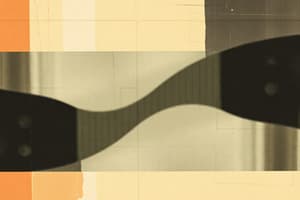Podcast
Questions and Answers
What is the main principle behind Malus' Law?
What is the main principle behind Malus' Law?
- The intensity of light increases as it passes through multiple polarizers.
- Unpolarized light is completely absorbed by a polarizer.
- The intensity of polarized light decreases with the angle between the light and the polarizer's axis. (correct)
- The intensity of polarized light remains constant regardless of the angle.
Which application is associated with thin film interference?
Which application is associated with thin film interference?
- Reducing glare through polarized sunglasses.
- Measuring the resolving power of microscopes.
- Determining the wavelength of light using a Michelson interferometer.
- Color patterns seen in soap bubbles and oil slicks. (correct)
In what scenario is wave optics preferred over ray optics?
In what scenario is wave optics preferred over ray optics?
- For applications involving straight-line propagation.
- When the object's size is comparable to the wavelength of light. (correct)
- In situations where light behaves like a particle.
- When dealing with large optical instruments.
What factor does NOT affect the diffraction pattern produced by an aperture?
What factor does NOT affect the diffraction pattern produced by an aperture?
Which of the following phenomena cannot be explained by ray optics?
Which of the following phenomena cannot be explained by ray optics?
What describes the result of constructive interference of light waves?
What describes the result of constructive interference of light waves?
What condition is essential for interference to occur in light waves?
What condition is essential for interference to occur in light waves?
What is a node in the context of wave interference?
What is a node in the context of wave interference?
How does the resolving power of an optical instrument typically change?
How does the resolving power of an optical instrument typically change?
What does Huygens' Principle state regarding wavefronts?
What does Huygens' Principle state regarding wavefronts?
What phenomenon occurs when light waves pass through an aperture and spread out?
What phenomenon occurs when light waves pass through an aperture and spread out?
What is the primary effect of polarization on light waves?
What is the primary effect of polarization on light waves?
What is the function of a diffraction grating in optics?
What is the function of a diffraction grating in optics?
Flashcards
Malus' Law
Malus' Law
Polarized light intensity diminishes when passing a polarizer. The angle between the polarizer and the light's polarization direction affects the intensity.
Interference (in optics)
Interference (in optics)
Combined effect of two or more light waves, resulting in either constructive or destructive interference patterns.
Thin Film Interference
Thin Film Interference
Light reflecting off different surfaces of a thin layer creates interference patterns. Used in observing color.
Wave Optics
Wave Optics
Signup and view all the flashcards
Ray Optics
Ray Optics
Signup and view all the flashcards
Huygens' Principle
Huygens' Principle
Signup and view all the flashcards
Interference
Interference
Signup and view all the flashcards
Young's Double-Slit
Young's Double-Slit
Signup and view all the flashcards
Diffraction
Diffraction
Signup and view all the flashcards
Diffraction Grating
Diffraction Grating
Signup and view all the flashcards
Resolving Power
Resolving Power
Signup and view all the flashcards
Polarization
Polarization
Signup and view all the flashcards
Study Notes
Wave Optics
-
Wave optics deals with the behaviour of light as a wave. It explains phenomena that cannot be explained by ray optics, such as interference, diffraction, and polarization.
-
Huygens' Principle: Every point on a wavefront can be considered as a source of secondary spherical wavelets. The forward envelope of these wavelets gives the new wavefront at a later time.
-
Interference of Light: Superposition of two or more light waves results in either reinforcement or cancellation of the waves. Constructive interference occurs when the waves are in phase, resulting in a brighter region. Destructive interference occurs when the waves are out of phase, resulting in a darker region.
-
Young's Double-Slit Experiment: A classic demonstration of interference. Two coherent light sources (obtained by splitting a single light source) produce interference patterns on a screen. The pattern shows alternating bright and dark fringes, confirming the wave nature of light. The position of the bright fringes is related to the wavelength of the light and the separation between the slits.
-
Conditions for Interference:
- The sources must be coherent (maintaining a constant phase difference).
- The waves must have the same wavelength.
- The amplitudes of the waves must be comparable.
-
Anti-node and Node: An anti-node is a point of maximum intensity, where constructive interference occurs. A node is a point of minimum intensity, where destructive interference occurs.
-
Diffraction: Bending of light waves as they pass through an obstacle or aperture. Diffraction patterns are characteristic of the size and shape of the obstacle. This bending of wavefronts is more pronounced when the size of the obstacle is comparable to the wavelength of the light.
-
Diffraction Grating: A device with many closely spaced slits that produces a more well-defined diffraction pattern than a double slit. Diffraction gratings are used to determine the wavelengths of light.
-
Resolving Power: The ability of an optical instrument to distinguish between two closely spaced objects. Higher resolving power allows for the observation of finer details. Resolving power improves with smaller wavelength and larger aperture.
-
Polarization of Light: Light waves are transverse, vibrating in a direction perpendicular to the direction of propagation. Polarized light has its vibrations confined to a specific plane. Polarization demonstrates the transverse nature of light waves.
-
Malus' Law: The intensity of polarized light transmitted through a polarizer decreases as the angle between the transmission axis of the polarizer and the polarization direction of the light changes.
-
Applications:
- Interference: Measurement of wavelength, testing flatness of surfaces, filters
- Diffraction: Spectroscopy, determination of wavelength, resolving power of microscopes
- Polarization: Polarizing sunglasses, LCD displays, stress analysis
-
Types of Interference:
- Young’s Double Slit Experiment: Light from two closely spaced narrow slits interfere.
- Thin Film Interference: Light reflecting off the top and bottom surfaces of a thin film interferes, showing coloured fringes. (e.g., soap bubbles, oil slicks)
- Interference in Michelson Interferometer: This device is used to measure wavelength and other physical parameters with high accuracy.
-
Diffraction patterns: Diffraction patterns depend on the wavelength and size of the aperture/obstacle. Examples include single slit diffraction, double slit diffraction, and diffraction grating patterns.
-
Polarization Effects: Polarization filters and polarizers are used in various applications like glare reduction, 3D movie projections, and optical instruments. Polarized sunglasses reduce glare by filtering the horizontally polarized component of light.
-
Difference between Wave Optics and Ray Optics: Wave optics considers the wave nature of light, predicting phenomena like interference and diffraction that are not explained by ray optics. Ray optics is a simpler model, providing a good approximation for many optical phenomena, especially when the wavelengths involved are small compared to the size of the optical elements.
Studying That Suits You
Use AI to generate personalized quizzes and flashcards to suit your learning preferences.




